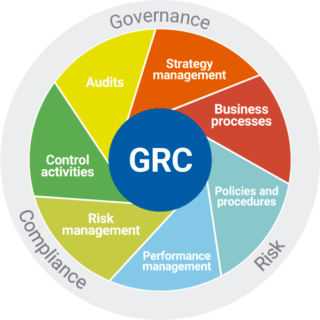
External and internal risk management requirements are becoming increasingly complex and intrusive, while the demand for more comprehensive and actionable governance, risk and compliance (GRC) information continues to increase:
- Managing risk in silos across different functions, processes, methods and infrastructure cannot keep up with these requirements
- Risk management has become a growing operational and financial burden, limiting the organizations’ ability to keep pace with essential business growth and transformational initiatives.
To manage today’s challenges, leading organizations are driving technology-enabled GRC transformation programs that can:
- Create improved visibility of enterprise risks and how these are mitigated
- Lower the cost of risk management through the reduction of manual processes and controls
- Increase efficiencies through standardization, simplification, automation and end-to-end process centralization
What is GRC?
GRC describes an organization’s integrated approach to governance, risk and compliance. It typically encompasses activities such as governance, enterprise risk management (ERM), internal controls, regulatory compliance and internal audit.
Governance improves the alignment of risk activities to the strategic objectives of the business. Governance activities enable clearer accountability and reporting, increase visibility of the risks that matter most to the organization, and enhance decision-making processes:
- Setting the business strategy and objectives
- Establishing the organization’s culture and values
- Defining the roles and responsibilities of risk governance bodies
- Determining risk appetite
- Setting standards and policies

Risk management embeds risk activities into business functions and processes and helps to ensure optimization across the enterprise. The following activities allow the performance of predictive analytics to correlate driver-based performance management and identify trends and anomalies for rapid response:
- Identifying and assessing risk that affect the organizations’ ability to achieve business objectives
- Determining risk response strategies
- Defining control activities
Compliance facilitates controls and processes to meet regulatory and business requirements. The following activities integrate automated controls measures and continuous monitoring into the transactional processing cycle, resulting in transparency of risk and controls and the elimination of transactions “at risk”:
- Testing adherence to control activities, policies, standards and commitments
- Addressing issue management, tracking and remediation
The Value of GRC Technology
Organizations use GRC technology to enable, integrate and optimize their risk management functions and processes, while focusing on supporting strategic objectives and creating value. GRC technologies successfully transform risk performance levels by:
- Automating and standardizing processes and controls
- Embedding and maintaining one single version of risk and control data
- Managing holistic views of risk and compliance exposures
- Generating dynamic and real-time risk and control intelligence and reporting
- Analyzing risk-driven indicators and exception-based decision making
- Escalating via work flow through different levels of the organization
Case Studies

Bank of India
Bank of India – Operational insight through improved data analysis. Galvanize technology has dramatically increased our audit confidence and coverage.

Lafarge
Lafarge north america – Lafarge streamlines complex data extraction and analysis with Galvanize analytics exchange

Dhan Lakshmi Bank
Incorporated in November 1927 at Kerala, India, Dhanlaxmi Bank Ltd. began with just Rs 11,000 (US $246) in capital..
READY TO TAKE THE NEXT STEPS WITH TRIDENT & GRC
Contact us today to schedule a quick chat about your project, or sign up for one of our monthly demos!



